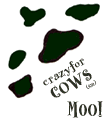|
|
|
|
|
|
|
Milk:
- Milk is the liquid from the mammary glands of female
mammals used for nourishing the young for a period of time beginning
immediately after birth.
- The milk of domesticated animals is a food source for humans.
- In Western countries most milk consumed is from our friends, the cows.
- Milk is an emulsion (a suspension of small particles of one liquid
in another where the two liquids do not mix) of fat and protein in water,
along with dissolved sugars (carbohydrates), minerals, and vitamins.
- In the stomach of someone who drinks milk, the milk is converted
into a soft curd that enables digestion to proceed smoothly.
- Lactose (milk sugar) is broken down into sugars that can be digested.
- The enzyme lactase is needed for the digestion of lactose.
- Some people don't produce lactase, and cannot digest milk sugar
without gastroinestinal problems. These people are said to be lactose
intolerant.
- Milk protein contains all essential amino acids.
- Milk contains enough calcium and phosphorus for normal skeletal development.
- Milk has little iron.
- Microorganisms found in raw (unheated) milk can sour and curdle the milk.
- Environmental bacteria that get into milk will do the same thing.
- Keeping milk to just above its freezing point keeps milk good for longer.
- Many countries require milk to be pasteurized.
- Pasteurization is a partial sterilization in which milk is heated to a
temperature high enough to destroy bacteria that cause illness and many bacteria
that cause the milk to go sour.
- Pasteurized milk kept in a closed container under refrigeration
will remain good for about 14 days.
- Milk fat is less dense than the other components of milk.
- The fat will rise to the top of milk if left to settle.
- Fat can also be removed effectively by a cream separator, which
uses centrifugal force to separate the fat from the milk.
- Whole milk contains about 4% fat. Low-fat milk contains 1 or 2 percent fat.
Skim milk has less than 1/2 percent fat.
- Most milk sold is homogenized. This means the milk has been forced
through small openings under pressure as a way to distribute the fat
evenly throughout the milk.
Source: Encyclopedia Brittanica online at http://www.brittanica.com,
entry Milk.
|
|



